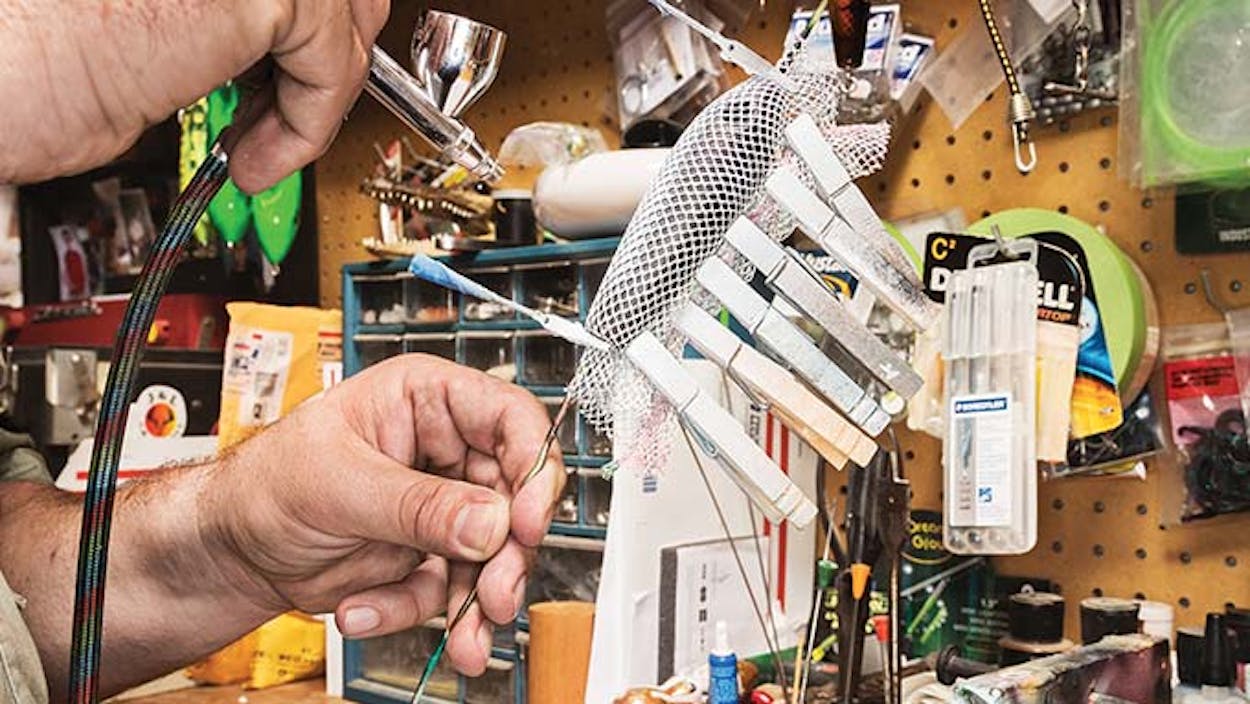Like any devoted fisherman, John Garcia can easily recall his most epic catch: a 27-inch trout he reeled in at age thirteen off the pier at Cole Park, in his hometown of Corpus Christi. Garcia learned to fish from his father, Daniel, who passed away in 1984; Daniel also encouraged his son’s artistic ambitions, buying him an airbrushing kit when he was twelve, which led to a side business painting custom designs on tailgates, motorcycles, and leather jackets. Years later, in 2008, a fishing friend at Garcia’s day job, at the Corpus Christi Army Depot, happened to bring in a wooden blank (or unpainted lure) he’d made. “It was plain-Jane,” Garcia recalls, “but I saw the potential for what it could be.” The two men formed a partnership, his friend making the blanks and Garcia airbrushing them in vibrant colors, producing what their co-workers called “hot-rod lures.” The venture took off, but his friend soon bowed out, so Garcia taught himself how to make the blanks. Today he works out of his garage—near a painting he did years ago of his father, clad in his signature cowboy hat and denim shirt—filling orders for professional fishermen and other enthusiasts. “Doing this full-time and making a living in fishing would be my dream,” Garcia says. “If I could, I would give my lures away for free. I love it that much.”
Q&A With John Garcia
Fishermen seem to love how your lures look, but they wouldn’t keep buying them if they didn’t catch fish, right?
Definitely not! That’s why I have a gallery on my website that shows fishermen from all over the country holding big fish they caught using Garcia Lures. I don’t even put captions or any text with the photos. A picture is worth a thousand words. But I do have a lot of customers who display my lures in their homes and never use them, because they have a hard time throwing them in the water.
How does the color on the lures stay so vibrant?
I seal the wood by soaking it in a special mix for eight hours and letting it dry for three days. When it dries, all the sealer soaks the wood and it becomes more dense. If you were to scratch all the way to the wood, the wood still wouldn’t absorb water, which makes it long-lasting. It also helps that I use a translucent paint that allows base colors and patterns to show certain effects.
You are primarily a saltwater fisherman. Do you have different lure designs for freshwater fishing?
I have some pro staffers who are bass fishermen, and they gave me suggestions for what colors work best for freshwater fishing. My four best-selling colors work great in both—gold, silver, blue, and green.
Do you ever fish with bait, or is it always with one of your lures?
When I fish for drum, which are bottom-feeders, I use bait, but I really prefer top-water fishing. There is nothing like the adrenaline you feel with top-water action. You can’t see the fish, and then the water explodes and he bites!
What’s the number one rookie mistake that you see novice fishermen and -women make?
It’s important to remember, there are two types of strikes in top-water fishing: either the fish will go all in and take the lure right away or, when a really big fish sees a good-sized lure, he will come up and hit it without opening his mouth to stun the bait, and then he will take it. I used to think it was a bite, but I learned to be patient. If he hits, don’t do a thing. That’s part of the discipline. I learned that from my dad and hopefully have passed it on to my two sons.
For more information, go to garcialures.com
- More About:
- Fishing







